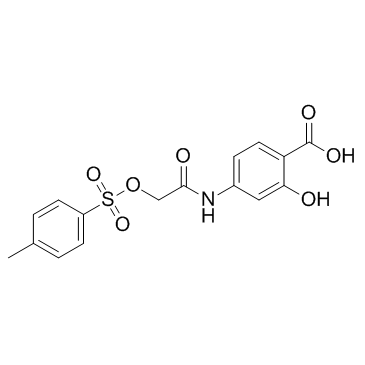501919-59-1
| Name | 2-hydroxy-4-[[2-(4-methylphenyl)sulfonyloxyacetyl]amino]benzoic acid |
|---|---|
| Synonyms |
Benzoic acid, 2-hydroxy-4-[[2-[[(4-methylphenyl)sulfonyl]oxy]acetyl]amino]-
S31-201 S3I-201 2-Hydroxy-4-[[[[(4-methylphenyl)sulfonyl]oxy]acetyl]amino]-benzoic acid 2-Hydroxy-4-[({[(4-methylphenyl)sulfonyl]oxy}acetyl)amino]benzoic acid 2-hydroxy-4-(2-(tosyloxy)acetamido)benzoic acid NSC 74859 |
| Description | NSC 74859 is a selective Stat3 inhibitor with an IC50 of 86±33 μM. |
|---|---|
| Related Catalog | |
| Target |
STAT3:86 μM (IC50) |
| In Vitro | NSC 74859 (S3I-201) preferentially inhibits Stat3 DNA-binding activity over that of Stat1 (IC50 values, Stat3•Stat3, 86±33 μM; Stat1•Stat3, 160±43 μM; and Stat1•Stat1, >300 μM) and inhibits that of Stat5 with IC50 of 166±17 μM). NSC 74859 significantly reduces viable cell numbers and inhibits growth of transformed mouse fibroblasts NIH 3T3/v-Src and breast carcinoma cell lines (MDA-MB-231, MDA-MB-435, and MDA-MB-468). At 30-100 μM, NSC 74859 induces significant apoptosis in the representative human breast carcinoma cell line MDA-MB-435 and NIH 3T3/v-Src, both of which harbor constitutively active Stat3. The breast carcinoma MDA-MB-435 cell line is more sensitive to 30 μM NSC 74859. By contrast, the human breast cancer MDA-MB-453 cells and the normal mouse fibroblasts (NIH 3T3), which do not contain abnormal Stat3 activity, are less sensitive to NSC 74859 at 100 μM or less. At 300 μM or higher, NSC 74859 induced general, nonspecific cytotoxicity independent of Stat3 activation status[1]. Huh-7 cells do not express β2SP or TBGFR2 and are sensitive to STAT3 inhibition, with an IC50 of 100 μM for NSC 74859, regardless of CD133+ status. The IC50 of NSC 74859 is 150 μM for Huh-7 and SNU-398 cells, 15 μM for SNU-475 cells and 200 μM for SNU-182 cells. NSC 74859 inhibits breast carcinoma MDA-MB-435, MDA-MB-453 and MDA-MB-231 cell lines with an IC50 close to 100 μM[2]. |
| In Vivo | Human breast (MDA-MB-231) tumor-bearing mice are given an i.v. injection of NSC 74859 (S3I-201) or vehicle every 2 or every 3 days for 2 weeks, and tumor measurements are taken every 2-3 days. Compared with control (vehicle-treated) tumors, which continued to grow, human breast tumors in mice that received S3I-201 display strong growth inhibition. Continued evaluation of treated mice on termination of treatment shows no resumption of tumor growth, suggesting potentially a long-lasting effect of S3I-201 on tumor growth[1]. Compared with vehicle-treated control tumors (n=15), which continued to grow, S3I-201 treatment of somatotroph tumor xenografts (n=15) significantly attenuated tumor growth for the duration of the experiment. Tumors derived from NSC 74859-treated rats are significantly smaller than those from the untreated group (220±16 mm3 vs. 287±16 mm3, P<0.01) as early as 5 days after NSC 74859 injection. Fifteen days after treatments, the average tumor volume of NSC 74859-treated rats is 64% of that of controls (449±40 mm3 vs. 708±83 mm3, P<0.01). Rats are sacrificed and tumors are harvested 15 days after treatment initiation. The average tumor weight of NSC 74859-treated rats is 78±8 mg, while tumors derived from control rats weighed 114±13 mg (32% reduction; P<0.05)[3]. |
| Cell Assay | Proliferating cells are treated with or without NSC 74859 (30-100 μM) for up to 48 h. In some cases, cells are first transfected with Stat3C, ST3-NT, or ST3-SH2 domain or mock-transfected for 24 h before treatment with compound for an additional 24-48 h. Cells are then detached and analyzed by annexin V binding and flow cytometry to quantify the percent apoptosis[1]. |
| Animal Admin | Mice[1] Six-week-old female athymic nude mice are used. Athymic nude mice are injected in the left flank area s.c. with 5×106 human breast cancer MDA-MB-231 cells in 100 μL of PBS. After 5-10 days, tumors with a diameter of 3 mm are established. Animals are given NSC 74859 i.v. at 5 mg/kg every 2 or 3 days for 2 weeks and monitored every 2 or 3 days. Animals are stratified so that the mean tumor sizes in all treatment are nearly identical. Tumor volume is calculated according to the formula V=0.52×a2×b, where a is the smallest superficial diameter and b is the largest superficial diameter. Rats[3] Four-week-old female Wistar Furth rats are used. GH3 cells (5×105 cells in 100 μL Matrigel) are subcutaneously injected into the left lumbar area. After 7 days, tumors with a volume of approximately 100 mm3 are established. Rats are given NSC 74859 intravenously at 5 mg/kg every 2 or 3 days for 2 weeks. Tumor size is measured by caliper measurements twice a week, and volume is calculated as follows: volume=(length×width2)/2. Three weeks after cell inoculations, animals are euthanized and excised tumors are weighed. Blood samples are collected 1 day before S3I-201 treatment and again on the day of euthanization. Serum GH and prolactin are assessed by RIA or ELISA, respectively. |
| References |
| Density | 1.5±0.1 g/cm3 |
|---|---|
| Boiling Point | 654.7±55.0 °C at 760 mmHg |
| Molecular Formula | C16H15NO7S |
| Molecular Weight | 365.358 |
| Flash Point | 349.8±31.5 °C |
| Exact Mass | 365.056915 |
| PSA | 138.38000 |
| LogP | 3.08 |
| Appearance | white to beige |
| Vapour Pressure | 0.0±2.1 mmHg at 25°C |
| Index of Refraction | 1.642 |
| Storage condition | ?20°C |
| Water Solubility | DMSO: >10mg/mL |
| RIDADR | NONH for all modes of transport |
|---|---|
| HS Code | 2924299090 |
|
~61% 
501919-59-1 |
| Literature: WO2007/136858 A2, ; Page/Page column 63 ; |
| HS Code | 2924299090 |
|---|---|
| Summary | 2924299090. other cyclic amides (including cyclic carbamates) and their derivatives; salts thereof. VAT:17.0%. Tax rebate rate:13.0%. . MFN tariff:6.5%. General tariff:30.0% |
